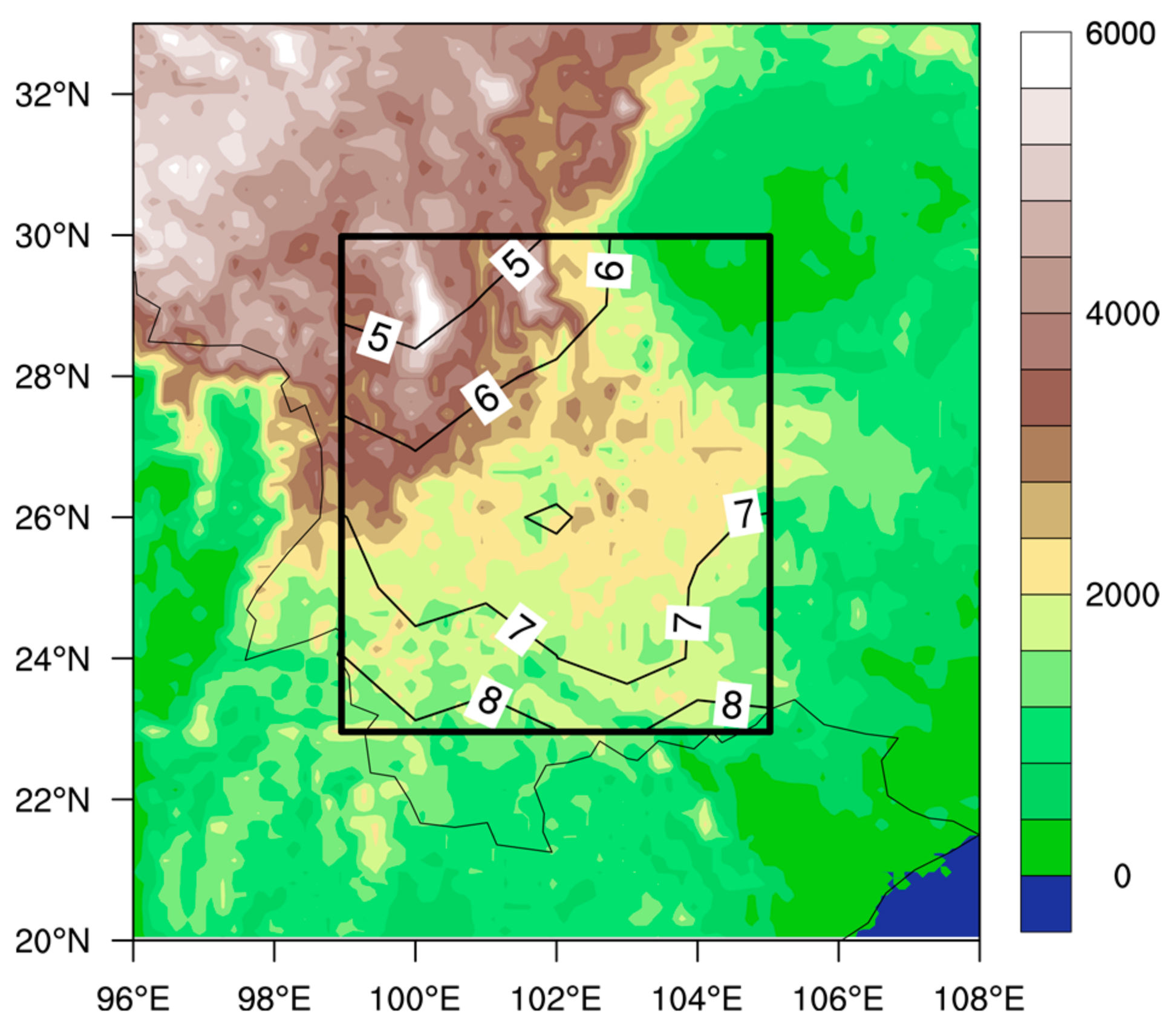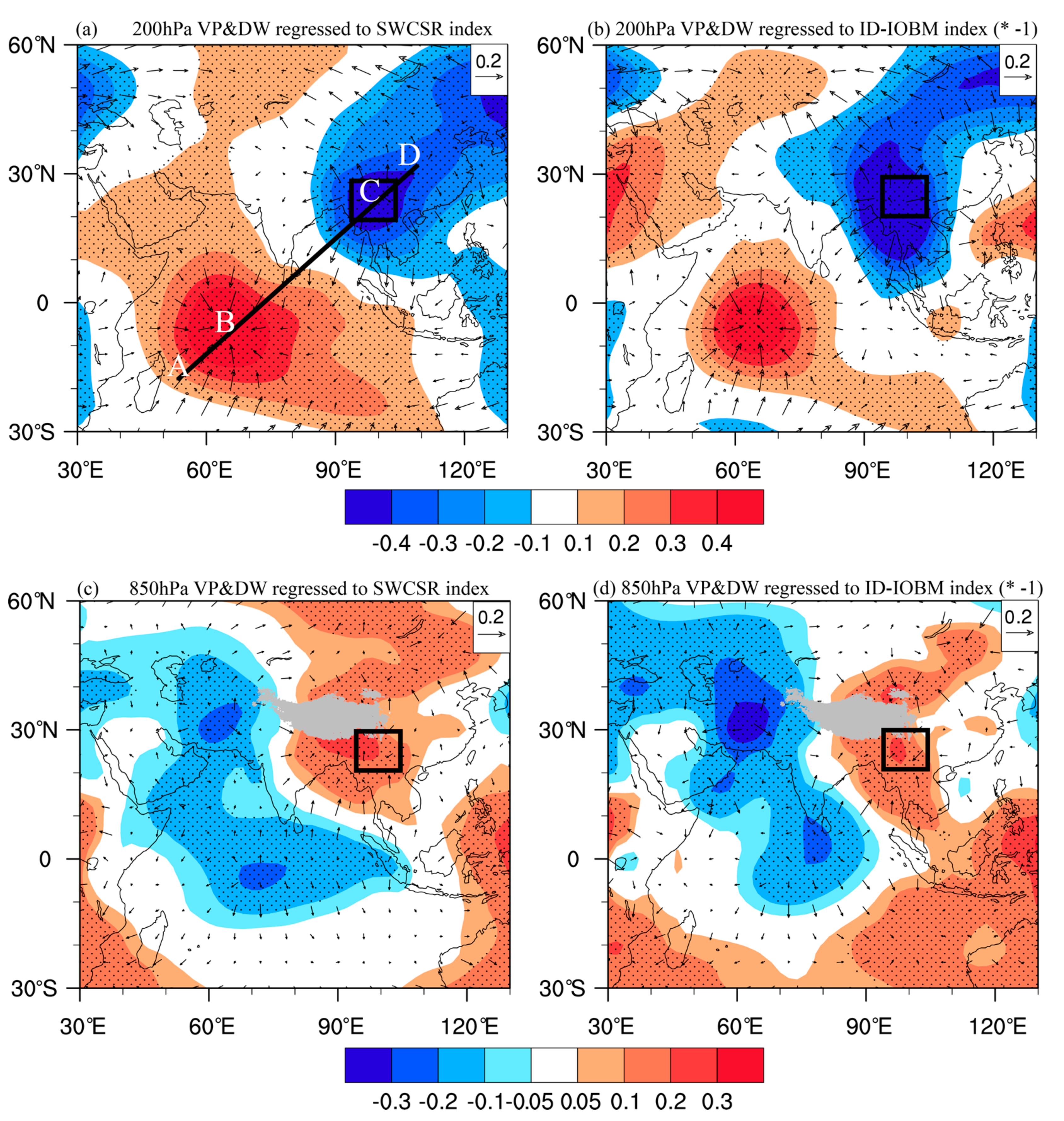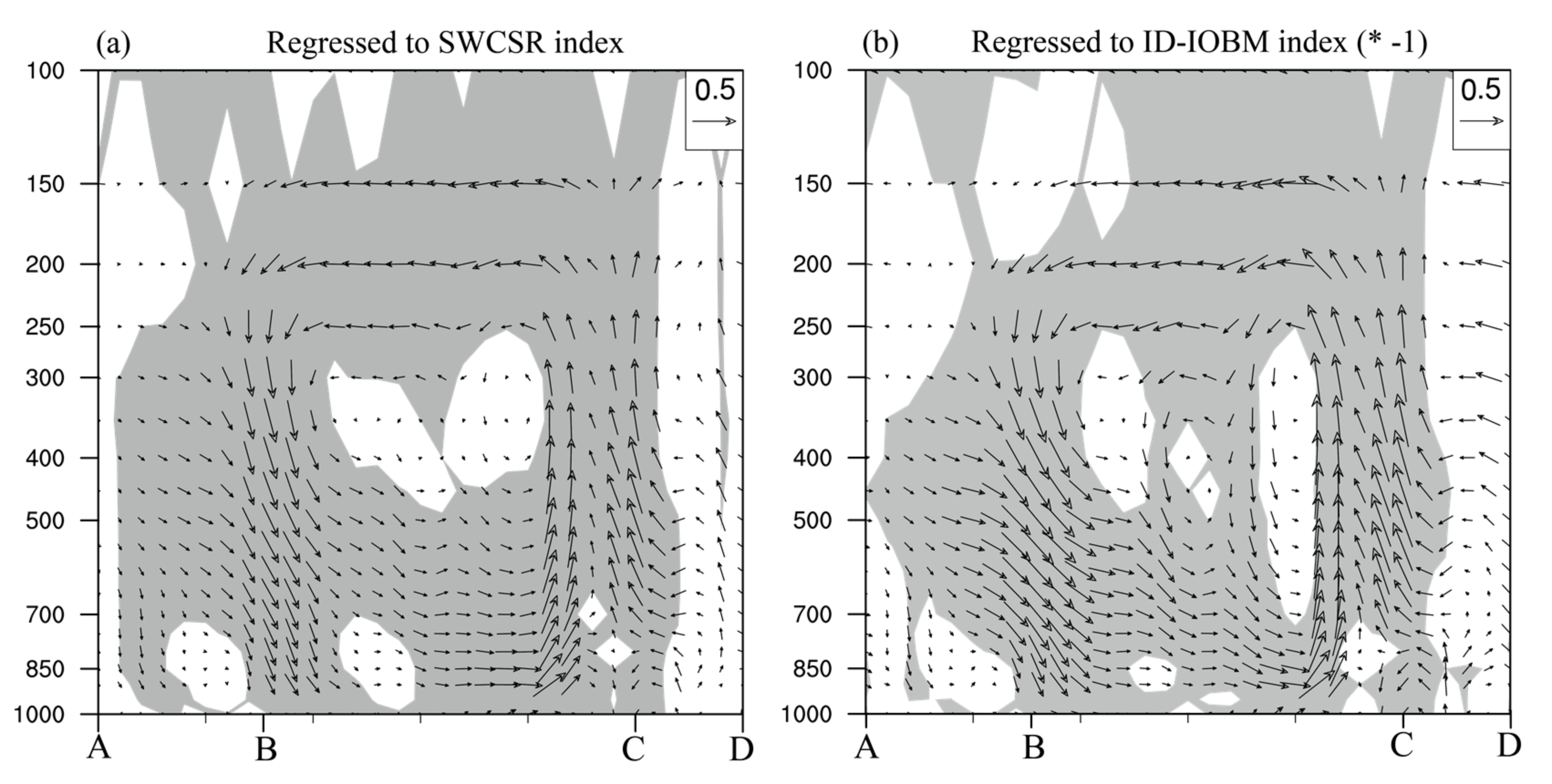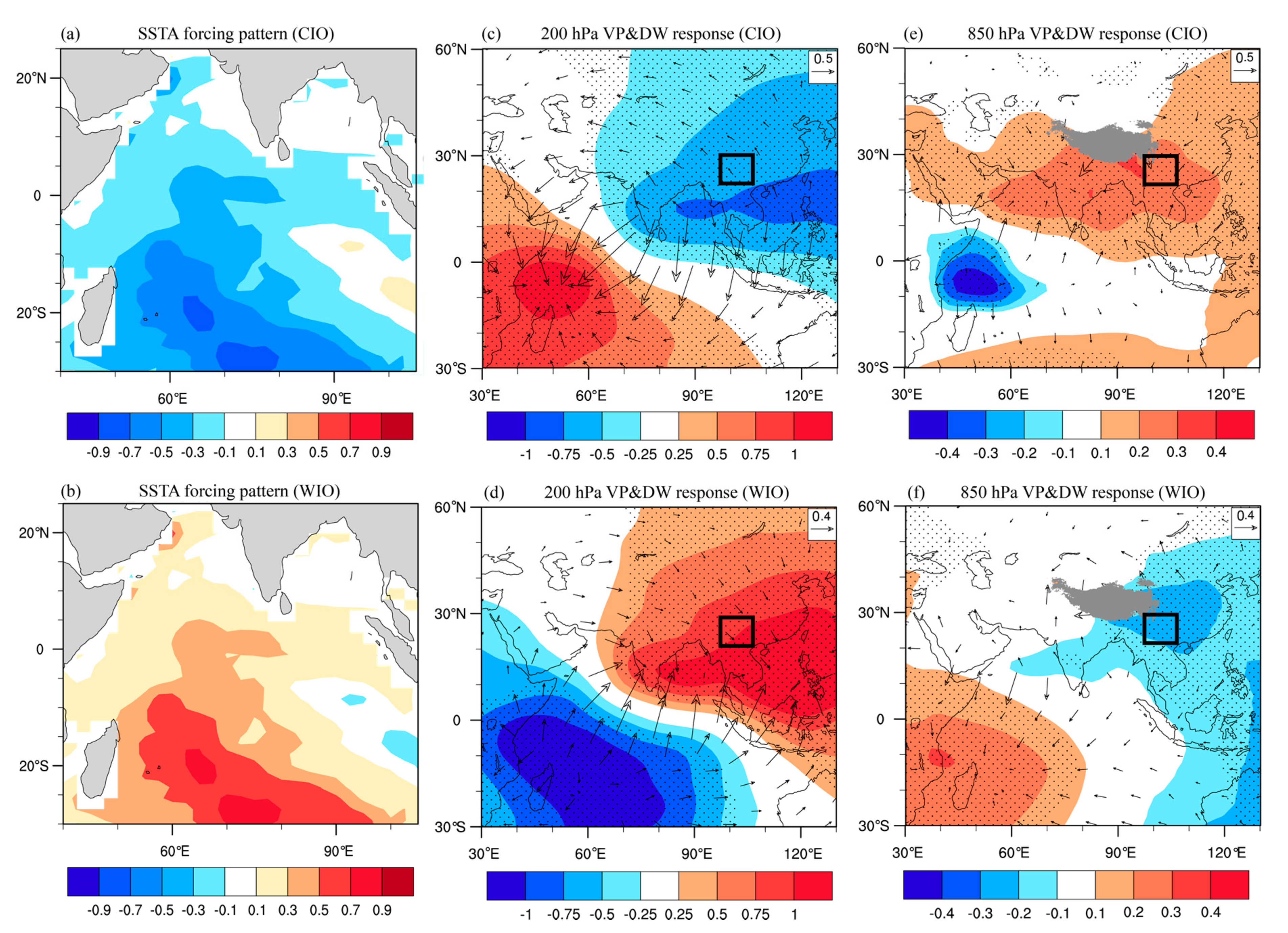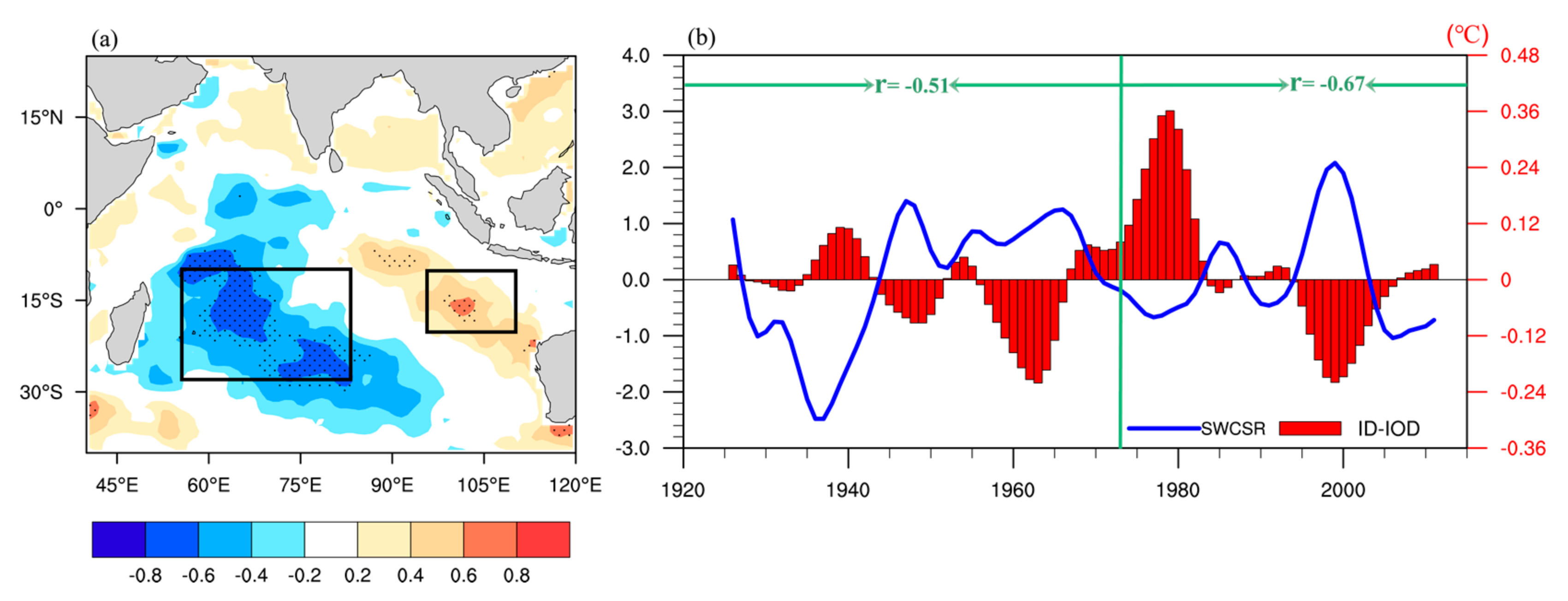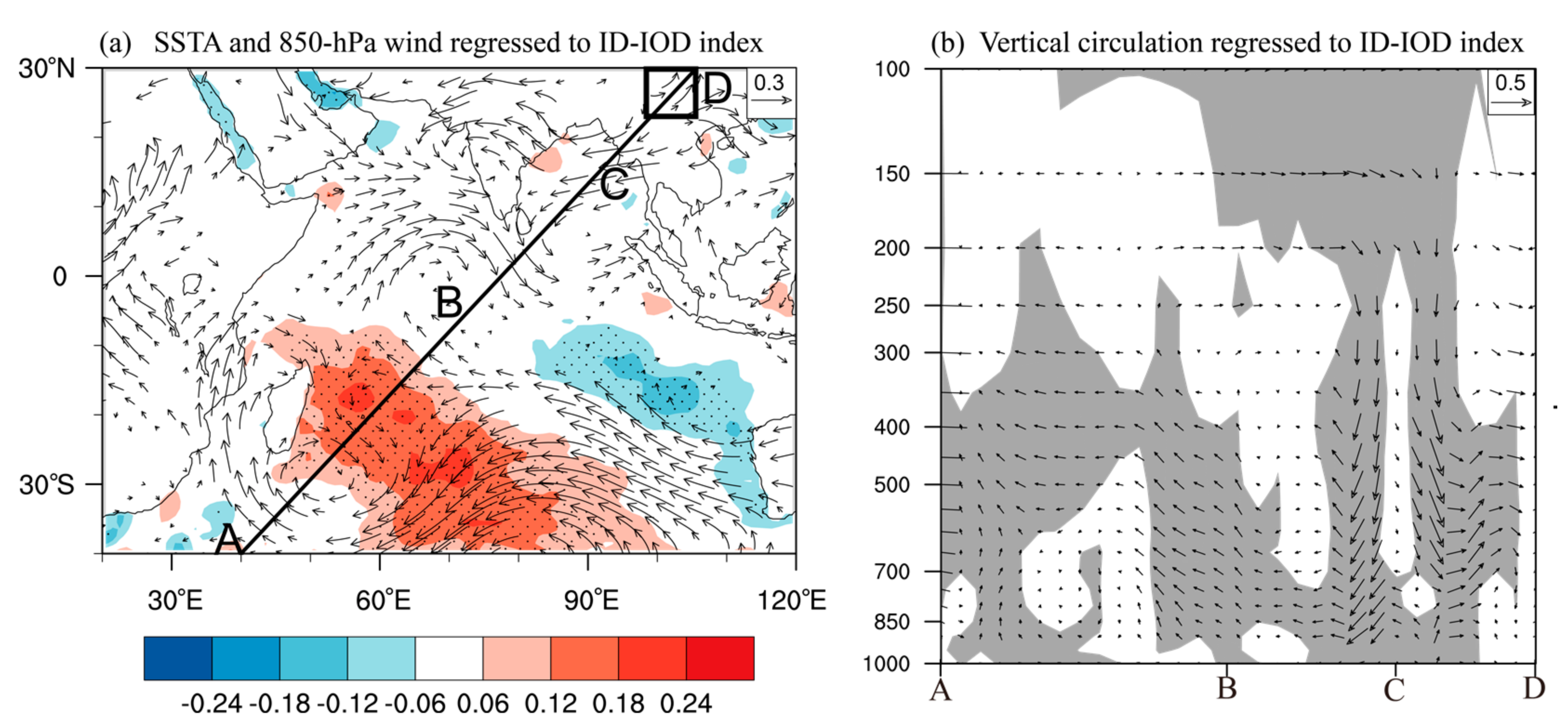1. Introduction
Southwestern China (SWC) is one of the most populated agricultural regions in China, providing approximately 16% of the national food supply [
1]. It contains the headwaters of many important rivers, including the Yangtze, Lancang, and Nujiang rivers, which provide as much as 46% of China’s available water resources [
1]. The terrain in this area is very complex. The average altitude in SWC (about 23–30° N and 99–105° E) exceeds 1500 m above sea level, shown in the rectangle in
Figure 1. The climatological summer rainfall in SWC gradually decreases from southeast to northwest, with values ranging between 5 mm day
−1 and 8 mm day
−1 (
Figure 1). Unlike flatlands, agriculture and ecosystems in this region are quite vulnerable to summer rainfall variability in low-latitude highlands [
2,
3].
Southwestern China summer rainfall (SWCSR) exhibits variability on a broad range of timescales. Large interannual variability often causes rainfall to vary from year to year [
4], whereas the interdecadal variability always results in persistent droughts and floods, which considerably impact the socio-economic development and the natural environment [
5]. Since 2006, the frequency of extreme droughts increased significantly in SWC. Record-breaking droughts hit SWC in the summer of 2006 [
6], the autumn of 2009 [
7], and the late summer of 2011 [
8], which have caused concern among the Chinese government, the public, and the academic sector. Most previous studies focused on the characteristics and the physical causes of SWCSR on interannual timescale [
2,
7,
8,
9,
10]. Therefore, understanding the primary features of the interdecadal variability of SWCSR and the associated mechanisms is both urgent and valuable.
With the Indian Ocean (IO) located southwest of SWC, some studies emphasized the strong influence of the IO on the decadal variability in East Asian summer climate, especially the Southeastern China summer rainfall (SECSR) [
11,
12]. The climatological SECSR is different from that in SWC. It gradually decreases from south to north with more abundant rainfall ranging between 6 mm day
−1 and 11 mm day
−1. Wu et al. [
11] revealed that the equatorial IO sea surface temperature (SST) had been increasing since the early 1990s, which led to the development of an anomalous lower-level anticyclone over the South China Sea and the Philippines. As a result, the SECSR increased. Zhang et al. [
12] revealed that the southern IO SST considerably impacted the interdecadal changes of the East Asian summer monsoon, which was featured by a decrease in the late 1970s and an increase in the early 1990s. An interdecadal cooling in the south IO triggered anomalous vertical overturning circulation, which led to a lower-level anticyclonic anomaly over the tropical northwestern Pacific. This pattern of circulation anomalies resulted in additional moisture transport into Southeastern China and subsequent rainfall increase. Cao et al. [
2] revealed that the subtropical Indian Ocean dipole was the main driver of the interannual variability of SWCSR. To date, the impacts of the IO on the interdecadal variability of SECSR have been extensively studied, whereas the impacts of the IO on the interdecadal variability of SWCSR are less understood. Therefore, the present study focused on the characteristics of interdecadal variability of SWCSR and their connections with the IO SST.
The rest of this paper is organized as follows:
Section 2 describes the datasets, methods, and model used in this study.
Section 3 investigates the relationship between interdecadal variability of SWCSR and the IO SST.
Section 4 describes the mechanisms used to connect the SST anomalies (SSTA) in the IO with the SWCSR. Finally, the discussionand summary are presented.
3. Association of Interdecadal Variability of SWCSR with IO SST
The longitude-time cross-section of observed SWCSR averaged between 23° N and 30° N is provided to reveal the temporal evolution characteristics of interdecadal SWCSR. As shown in
Figure 2, the SWCSR displays apparent drought and flood periods during 1926 to 2011, which indicates an evident interdecadal signal in the SWCSR. Flood periods occurred from 1944 to 1971 and 1994 to 2003, whereas drought periods occurred from 1926–1943, 1972–1993, and 2004–2011. The positive (negative) phase of the SWCSR is characterized by increased (decreased) rainfall in SWC. Notably, since the beginning of the 2000s, SWCSR transitioned into a negative phase, which could be considered the interdecadal background of frequent extreme droughts during the past decade [
8]. Hereafter, the average rainfall anomalies in SWC, highlighted by the rectangle in
Figure 1, is defined as the SWCSR index for further analyses. We aimed to determine the mechanisms responsible for the interdecadal variability of SWCSR.
SSTA play crucial roles in the interdecadal variability in rainfall and the associated large-scale atmospheric circulation over East Asia [
21,
22].
Figure 3a shows the correlation coefficients between SSTA and the SWCSR index for the period of 1926 to 2011. The most significant correlation is found in the IO, which exhibits a basin-wide monopole pattern, whereas an only limited significant correlation area was observed in the Pacific and the Atlantic. This SST pattern in the IO is similar to the conventional IO basin mode (IOBM) that was defined on interannual timescale [
23,
24]. Given this resemblance, the interdecadal basin-wide mode of IO SST is termed the ID-IOBM in this study. The warm (cold) phase of the ID-IOBM is characterized by warming (cooling) in the entire IO. The average SST anomaliesin the IO is calculated, which is defined as the ID-IOBM index, shown by the red bars in
Figure 3b.
Figure 3b also shows the SWCSR and the ID-IOBM indices. The correlation coefficient between the SWCSR index derived from GPCC data (the black line in
Figure 3b) and the ID-IOBM index is –0.78 for the period of 1926 to 2011, which is significant at the 95% confidence level, suggesting that the ID-IOBM is closely negatively correlated with the SWCSR. When the ID-IOBM is in its cold phase with below-normal SST over the entire IO, summer rainfall tends to be abundant in SWC. To further confirm the results, the SWCSR index was also calculated using the NMIC observed grid data, shown by the blue line in
Figure 3b. The correlation coefficient between the two SWCSR indices, derived from GPCC and NMIC data, is 0.90 for the period of 1926 to 2011, which is significant at the 99% confidence level, indicating that the interdecadal variability of SWCSR is robust in observational rainfall data. The correlation coefficient between the SWCSR index derived from the NMIC data and the ID-IOBM index is −0.77, which is significant at the 95% confidence level, showing a steady relationship between the ID-IOBM and the SWCSR, irrespective of the rainfall data used. Hereafter, the SWCSR index derived from the NMIC data is used for further analyses.
Previous studies demonstrated that the interdecadal variation of rainfall is always accompanied by atmospheric circulation variability [
25,
26]. Therefore, summer atmospheric circulation patterns associated with the SWCSR and the ID-IOBM indices were investigated to verify the interdecadal connection between the SWCSR and the ID-IOBM (
Figure 4). Note that the sign of the ID-IOBM index is reversed during regression analyses to represent the impacts of the cold phase of the ID-IOBM.
The stream function patterns regressed against the SWCSR index and the ID-IOBM index at 200 hPa are shown in
Figure 4a,b, respectively. From
Figure 4a, the most distinct signal associated with the SWCSR was the positive action center (above-normal center of stream function) located over the Indo-China peninsula, which is favorable for upper-level divergence and the accompanying ascending motion. The highly similar features are outlined in
Figure 4b.
Figure 4c,d show the regressed stream function patterns at 500 hPa. The common characteristics between
Figure 4c,d are the significant positive action center located over the Indo-China peninsula and the negative action center over IO, indicating an anomalous ascending motion over the Indo-China peninsula and a descending motion over the tropical IO. The lower-level circulation anomalies associated with the SWCSR index, as shown in
Figure 4e, exhibit opposite patterns to the upper level, including prevailing westerly wind anomalies over the entire tropical IO and an anomalous cyclone over the Indo-China peninsula. Significant westerly anomalies are observed at the west flank of the cyclone, which may strengthen the moisture transport from the Bay of Bengal (BOB) to SWC. The lower-level circulation anomalies associated with the ID-IOBM index (
Figure 4f) have a similar pattern to that shown in
Figure 4e.
Based on these circulation results, we inferred that the anomalous cyclone over the Indo-China peninsula at 850 hPa may impact the SWCSR by strengthening the moisture transport from the BOB to SWC. The anomalous negative action center at 500 hPa and the positive action center at 200 hPa favor the anomalous ascending motion over the Indo-China peninsula, corresponding well with the anomalous cyclone at 850 hPa. The combined effects of the anomalous ascending motion and the above-normal moisture transport are favorable for above-normal SWCSR. Notably, the anomalous circulation patterns associated with the cold phase of the ID-IOBM (
Figure 4b,d,f) and the positive phase of the SWCSR (
Figure 4a,c,e) are very similar. Therefore, these circulation anomalies may act as the bridge connecting the SWCSR with the ID-IOBM.
5. Discussion
In
Figure 3b, it is interesting to note that the amplitude of ID-IOBM is gradually decreasing after the beginning of 1970s, while the variability of SWCSR does not show such a change. Are there any other potential factors that can have impacts on the SWCSR?
To explain such a phenomenon, we calculate the correlation coefficients between the IO SSTA and the SWCSR index after remove the ID-IOBM from the IO SSTA, which displays a significant dipole pattern (
Figure 8a). The SSTA in the southwestern (southeastern) Indian Ocean is negatively (positively) correlated with the SWCSR index. This pattern is termed the interdecadal Indian Ocean dipole (ID-IOD) hereafter. The positive phase of the ID-IOD is characterized by above-normal (below-normal) SSTA in the southwestern (southeastern) IO, and vice versa. The ID-IOD is quite different from the conventional IOD, which is active mainly in the tropical IO on interannual timescale in boreal autumn [
28,
29]. The difference between the average SSTA in 28° S–10° S, 55° E–83° E and 20° S–10° S, 95° E–110° E (rectangles in
Figure 8a) is defined as the ID-IOD index (
Figure 8b). The amplitude of ID-IOD is increasing after the beginning of 1970s, which may be responsible for the decreasing amplitude of ID-IOBM in the recent past decades.
To investigate the possible relationship between ID-IOD and SWCSR, the correlation coefficient between the SWCSR index and the ID-IOD index is calculated, which is −0.51 (not significant) for the period of 1926–1972 and is −0.67 (significant at the 90% confidence level) for the period of 1973–2011, indicating that the SWCSR is more closely associated with the ID-IOD after the beginning of 1970s. The relatively low correlation between the SWCSR index and the ID-IOD index before 1970s is possibly due to the weak amplitude of simultaneous ID-IOD.
To further investigate the possible influence of the ID-IOD on the SWCSR and associated physical processes, we analyzed SSTA and circulation anomalies associated with the ID-IOD.
Figure 9a shows that the regressed SSTA against the ID-IOD index in the IO displays an apparent dipole pattern in the southern IO, which is similar to the conventional subtropical Indian Ocean dipole defined on interannual timescale [
30]. The anomalous easterlies prevail over the subtropical south IO, resulting in anomalous convergence over the southwestern IO and the central tropical IO, corresponding to a regional ascending motion.
Figure 9b shows that the anomalous ascending motion over the central tropical IO is accompanied with anomalous upper-level divergence. One branch of the corresponding upper-level outflows converges over the Indo-China peninsula, which is favorable for anomalous descending motion and lower-level northeasterly anomalies, both of which favor decreased rainfall in SWC. This is consistent with the results revealed by Cao et al. [
2], who showed that the summer rainfall in SWC is negatively connected with the subtropical Indian Ocean dipole on interannual timescale. The positive subtropical Indian Ocean dipole facilitated easterly anomalies off the eastern coast of BOB and weakened climatological water vapor flux to the northern BOB. As a result, anomalous water vapor divergence and less rainfall was observed over the SWC.
Therefore, the decreasing amplitude of ID-IOBM in the recent past may be related to the increasing amplitude of ID-IOD. After the beginning of 1970s, the impacts of ID-IOD on SWCSR is strengthening. The combined impacts of ID-IOBM and ID-IOD sustained the variability of SWCSR. The ID-IOBM is closely associated with the SWCSR for the whole period of 1926–2011. However, the impacts of ID-IOD on SWCSR is relatively weak before 1970s, indicating that the ID-IOD is the secondary driver of the interdecadal variability of SWCSR.
Though the SECSR and SWCSR are neighboring regions, the relationship between ID-IOBM and SECSR are quite different from the ID-IOBM and SWCSR relationship. We studied the relationship between ID-IOBM and SECSR separately [
31], which is beyond the scope of this work.
These results provide an efficient prediction potential for summer rainfall variations, especially for extreme droughts and floods over SWC. With the Tibetan Plateau to the northwest of the SWC, the influence on the interdecadal variability of SWCSR is worth studying in the future. Our efforts in this study were dedicated to studying the historical changes and causes of SWC; however, the future changes in drought risk in SWC under global warming need to be further studied. This information is crucial to advance planning for agricultural adaptation and water resource management. Therefore, a multimodel projection of future rainfall in SWC will be completed in the future.
6. Summary
In this study, we focused on the characteristics of the intedecadal variability of SWCSR and its relationship with the IO SST through observational analyses and model simulation experiments. We found a remarkable negative correlation between the SWCSR and the ID-IOBM in summer. The dynamic processes linking the SWCSR to the ID-IOBM were then examined.
The SWCSR displays apparent drought and flood periods during 1926–2011, which indicates an evident interdecadal signal in the SWCSR. Flood periods were 1944–1971 and 1994–2003, whereas drought periods were 1926–1943, 1972–1993, and 2004–2011. The SWCSR was negatively correlated with the ID-IOBM, which induced the anomalous inter-hemispheric vertical circulation between the tropical IO and the Indo-China peninsula. During the cold phase of the ID-IOBM, an enhanced lower-level divergence and an upper-level convergence occurred over the tropical IO. The corresponding lower-level outflow anomalies from the tropical IO converged over the Indo-China peninsula, corresponding to a lower-level anomalous cyclone that contributed to the increase in the eastward moisture transport from the BOB into SWC. Therefore, the increased moisture transport, and the anomalous ascending motion associated with the inter-hemispheric vertical circulation over SWC, increased SWCSR. In summer during the warm phase of the ID-IOBM, the situation is approximately the same, but with opposite polarity.
After the beginning of 1970s, the impacts of ID-IOD on SWCSR is strengthening. During the warm (cold) phase of the ID-IOD, an anomalous vertical circulation located between the tropical central IOand Indo-China peninsula is in favor of decreased (increased) rainfall in SWC. However, the impacts of ID-IOD on SWCSR is relatively weak before the 1970s, indicating that the ID-IOD is the secondary driver of the interdecadal variability of SWCSR.
The impacts of the ID-IOBM on the circulation anomalies associated with the interdecadal variability of SWCSR were further verified using numerical modeling experiments. The results of the sensitivity experiments showed an apparent anomalous inter-hemispheric circulation response to both the cold and warm phases of the ID-IOBM pattern, though the location of the anomalies over the IO displayed small differences from observations, and the amplitude of the response was somewhat greater than that found in the observations.
